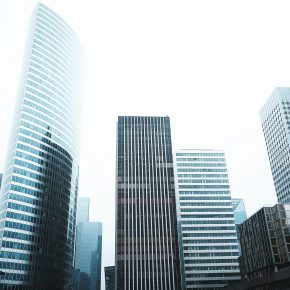
Mitsubishi Electric: To reach net-zero, commercial buildings must be designed with sustainability in mind
 The government’s Build Back Greener strategy has recently set out a clear proposal for achieving net-zero carbon emissions in the UK by 2050. To get there, a concerted and immediate shift towards the use of lower carbon technologies is now vital. At the same time, both businesses and consumers are becoming increasingly aware of the environmental impact of everything around them. As a result, buildings must now be designed with sustainability in mind, and equipped with systems that can meet the demands of both stricter legislation and more environmentally conscious customers. Mike Egan, Business Development Manager for Mitsubishi Electric’s Corporate Solutions Team, has more…
The government’s Build Back Greener strategy has recently set out a clear proposal for achieving net-zero carbon emissions in the UK by 2050. To get there, a concerted and immediate shift towards the use of lower carbon technologies is now vital. At the same time, both businesses and consumers are becoming increasingly aware of the environmental impact of everything around them. As a result, buildings must now be designed with sustainability in mind, and equipped with systems that can meet the demands of both stricter legislation and more environmentally conscious customers. Mike Egan, Business Development Manager for Mitsubishi Electric’s Corporate Solutions Team, has more…
Commercial spaces, such as hotels, shopping centres and managed apartment blocks, contribute significantly towards global carbon emissions. Therefore, it’s important that property developers shift their focus towards how these spaces are built, and rethink the technologies that heat, cool and ventilate them.
While HVAC systems play a crucial role in keeping occupants comfortable in commercial spaces, they can also consume a large amount of energy and contribute to the building’s carbon emissions as a result. There are a number of solutions designed for every space that can provide the public with the comfort they need, while also meeting standards for energy efficiency and carbon reduction, that are applicable today
A move to renewable heating
With heating and hot water accounting for around 40% of overall carbon emissions, finding less energy intensive solutions needs to be a key focus when building or refurbishing commercial properties.
When it comes to managed apartment blocks, numerous homes need access to heating and hot water, however the commercial heating solutions typically deployed in these buildings can often be very carbon intensive. However, with a high temperature heat pump like the 40kW Ecodan QAHV, it’s possible to deliver hot water of up to 90°C, allowing buildings to increase the efficiency of their hot water production while also reducing their carbon footprint.
Blocks like these often form part of mixed-use buildings, where residential homes and shops, gyms or cafes are located alongside one another. These spaces also provide excellent opportunities for utilising heat recovery technology, where the excess heat from cooling an indoor space like a gym can be recovered to heat the flats above – significantly reducing the amount of energy needed to heat and cool the building.
A key example of this was the deployment of a heat recovery system at 48 Leicester Square in central London. The installation of the City Multi VRF system was able to provide energy efficient heating and cooling to each individual zone of the eight-storey building, resulting in energy savings of up to 30% compared to conventional systems.
Keeping spaces cool
Keeping building occupants cool, comfortable and productive all year round is also important – whether it’s in an office, gym, restaurant or office.
Looking for natural solutions first is an important way to keep carbon impact down – including clever use of natural ventilation to lower peak temperatures inside buildings, or designing spaces to stop them becoming heat spots in the first place, with things like solar shading and trees and green walls to provide cooling and ventilation.
Where air conditioning is needed, systems that maximise heat recovery can also help to reduce energy use. By heating one area while simultaneously cooling another, building managers can improve the energy efficiency of their building, while also minimising running costs. For modern mixed-use buildings in particular, this approach can enable heat energy from cooling gyms, offices and retail outlets to be used to provide hot water for the apartments above.
These systems also utilise refrigerants with much lower global warming potential (GWP) in order to deliver greater flexibility of design and operation. This enables building owners and developers to comply with existing regulations, and ensure that their buildings are prepared for a planned phase down of F-Gases-helping to protect against future climate legislation.
While guest comfort is a key consideration in the hotel industry, it’s important not to downplay the significance of sustainability and cost. With technology like Hybrid Variable Refrigerant Flow (HVRF) air conditioning systems, water replaces refrigerant to transfer heating and cooling around the majority of the building. This can help keep guests comfortable, while also removing the need for expensive leak detection.
Ventilating for occupant wellbeing
The COVID-19 pandemic has highlighted the importance of correctly ventilating indoor spaces, and consumers are becoming increasingly aware of the impact that poor air quality has on their health and wellbeing as a result. This has been further emphasised with the proposed introduction of legislation such as the Clean Air Bill, which seeks to establish the right to clean air in UK law.
With people spending up to 90% of their time indoors, it’s vital to ensure that spaces such as offices, restaurants, gyms and shopping centres are properly ventilated. In particular, solutions like Mechanical Ventilation with Heat Recovery (MVHR) are able to supply fresh air to indoor areas by extracting stale air from the inside of the building, while also retaining the energy used during heating. This provides a constant supply of clean air to shoppers and guests, without compromising on energy efficiency.
With buildings increasingly having to meet strict legislation and ambitious targets for net zero, it’s more important than ever that developers of commercial buildings adapt their spaces accordingly. By selecting the right equipment and technology, property owners and developers can ensure their buildings are protected against future climate change targets, while also providing year-round comfort for shoppers and guests.
Mitsubishi Electric Living Systems,
Travellers Lane,
Hatfield,
Hertfordshire,
AL10 8XB
United Kingdom
Visit Mitsubishi Electric Living System's website
Visit Supplier's page
Latest news

19th April 2024
ASSA ABLOY: Access solutions can impact sustainability performance across the full life-cycle of a building
Embedding sustainability within any organisation requires a broad, strategic perspective. Scrutiny should include the physical infrastructure itself: According to the IEA, buildings consume around 30% of global energy*. ASSA ABLOY has more…
Posted in Access Control & Door Entry Systems, Architectural Ironmongery, Articles, Building Industry News, Building Products & Structures, Building Regulations & Accreditations, Building Services, Case Studies, Doors, Facility Management & Building Services, Information Technology, Research & Materials Testing, Retrofit & Renovation, Security and Fire Protection, Sustainability & Energy Efficiency, Video of the Week
19th April 2024
British weather doesn't dampen spirit for new HMG Garden Paint
Despite one of the wettest starts to the year on record, customers are starting to plan for brighter days with HydroPro Garden Paint from HMG Paints.
Posted in Articles, Building Industry News, Building Products & Structures, Garden, Innovations & New Products, Paints, Paints, Coatings & Finishes, Restoration & Refurbishment, Retrofit & Renovation, Site Preparation, Sustainability & Energy Efficiency, Waste Management & Recycling
18th April 2024
Abloy UK showcases new digital portfolio at The Security Event 2024
Abloy UK is set to unveil its latest line-up of access control systems at The Security Event 2024, welcoming guests to explore its cutting-edge electromechanical and digital solutions on stand 5/F50.
Posted in Access Control & Door Entry Systems, Architectural Ironmongery, Articles, Building Industry Events, Building Industry News, Building Products & Structures, Building Services, Doors, Exhibitions and Conferences, Facility Management & Building Services, Health & Safety, Information Technology, Retrofit & Renovation, Security and Fire Protection
18th April 2024
Strand is a Failsafe Choice for Emergency Exit and Panic Hardware
In times of emergency, you’re in safe hands with Strand Hardware. Although there are many considerations for building specification, few decisions can be as critical as selecting the right emergency exit/panic hardware.
Posted in Access Control & Door Entry Systems, Architectural Ironmongery, Articles, Building Industry News, Building Products & Structures, Building Services, Doors, Facility Management & Building Services, Health & Safety, Restoration & Refurbishment, Retrofit & Renovation, Security and Fire Protection
 Sign up:
Sign up: